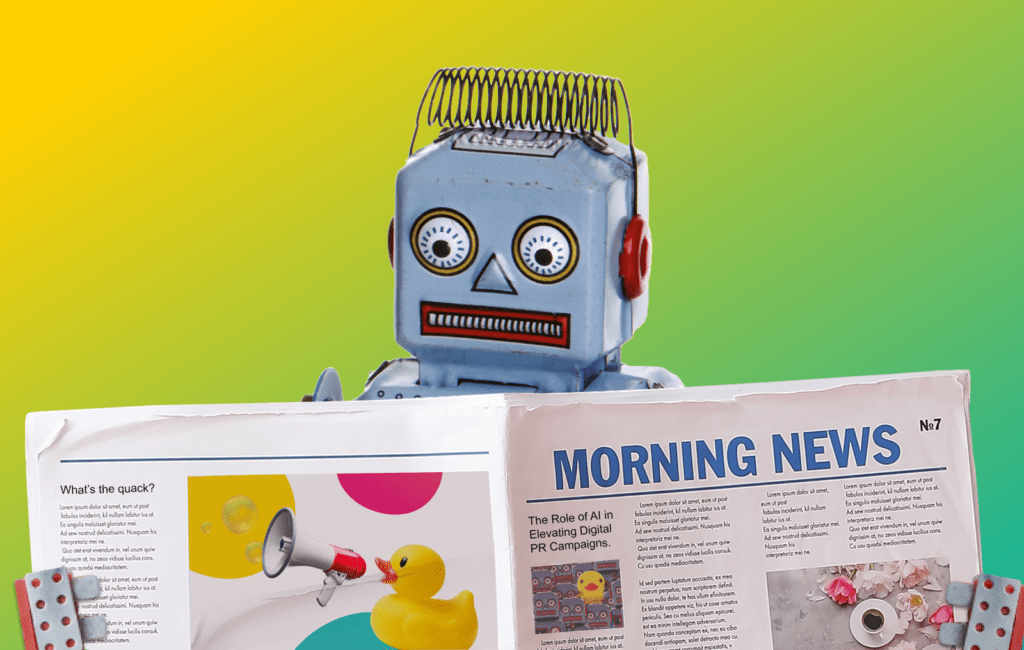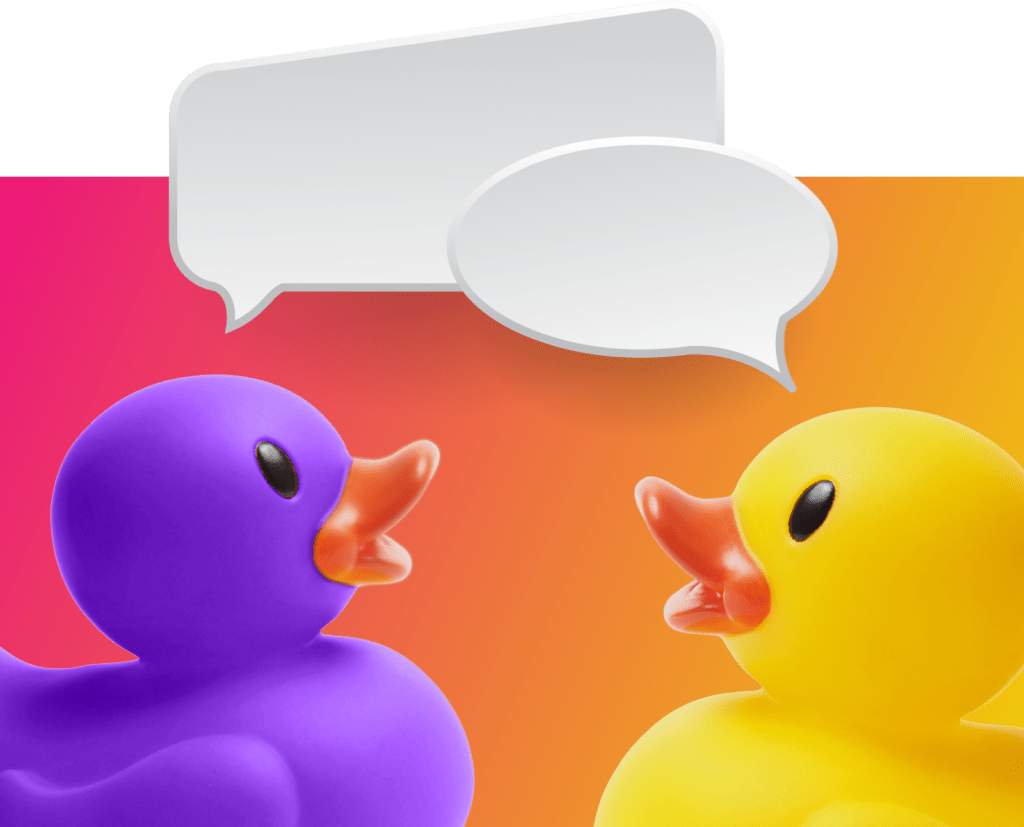We’ve recently been talking about how digital PR is set to be one of the most important weapons in your arsenal going into 2025. With that in mind, we thought it was high time to follow up on how digital PR is going to be shaped by the ongoing presence of AI.
In our ongoing series on using AI in digital marketing, we said that 60% of PR professionals are already making use of AI. If we’re urging you to step up your PR efforts in 2025, then we really need to have a chat about the best ways to make use of AI!
If you’ve been following our series for the last few months, you’ll know that we’re very in favour of using AI ethically and responsibly in marketing, but we invariably advise caution when AI tempts you to get lazy or relax your standards.
We’re very much in the same camp when it comes to using AI effectively with digital PR.
Join us as we explore how to use (and how not to use!) AI to step up your PR if you’re looking to thrive in the ever-changing world of online marketing.
TL;DR: Digital PR can effectively leverage AI within tasks such as list building, publication analysis, ideation and message creation, and also offer an informed second opinion. However, PR quite literally means “public relations”, and overusing AI can create a severe lack of empathy and a limited approach that can leave your customers feeling uncared for, inflicting untold damage to your brand perception. You should use AI to help you to research and then take action based upon its findings.
How Not To Do Public Relations
To begin with, we want to reiterate a point that we’ve touched upon in previous articles like our exploration of AI and SEO, but it’s perhaps even more important in a PR context:
Overusing AI for content writing will all too often result in a lack of unique information, a tone of voice that blends in with the crowd, and a lot of thoughts that are pretty run-of-the-mill.
Don’t get us wrong, AI content has its uses. For example, in the form of chatbots it can be great. Speedy responses are highly valued by most, but if those responses lack empathy or scream out as being artificial and inflexible, then they’re going to cause problems too.
It’s the same when you use too much AI to create your PR content.
AI-generated influencers are already doing very well, but what about the number of users who pay less attention to an entity that they know is AI-based? People care about authenticity, and we think that’s only going to get more common. It’s one of the reasons why videos are successful right now. Although they can be faked, they project a face-value air of genuineness that a (potentially easily AI-created) written comment can’t match. And make no mistake, your consumer base will spot too much AI usage, and will probably wonder why you can’t take the time to talk to them yourselves.
When your goal is public relations, that’s a disastrous impression to make!
Hubspot reports that a single bad experience with a brand can result in 50% of consumers giving up on that brand. Although there’s not always a definite correlation, too much use of AI text can also suggest a lack of quality (i.e. Google’s March core update was in part cracking down on low-quality AI content… not all AI content, but some more casual observers won’t make that distinction!). If your brand becomes associated with poor quality and lack of personality or empathy, then you’re going to need a lot of additional (good) PR to recover your reputation.
How We’re Using AI in Digital PR

Now we’ve told you how we’re not using AI in digital PR, how about we cover how we are using it?!
To summarise our stance, we like to use AI in a balanced way to help us learn.
As we’ve said before, AI is fast, helpful, and essentially like having another team member. It can do a lot of legwork during the research stages of a project, and do so quickly, leaving our experts to take action when they’re armed with loads of great information in no time at all.
Here are some of our favourite ways to use AI in PR.
List Building
We love doing PR the old-fashioned way, but even we sometimes have to admit that the research stages take a long time, especially when we want to be as thorough as possible.
A classic example of a way that AI can ease the research burden is when we’re list building.
Using a generative AI tool, we can create a prompt to outline that we’re working with a partner within a particular industry and describe that this partner wants to be featured in a certain type of publication. We can relay that we’re looking to create a piece of content that covers a theme that’s relevant to this partner and request a list of publications within a suitable niche. The findings of our chosen AI tool will then form the basis of a list that we can manually check out, or plug into our list-building software for further investigation.
Sure, we could have found the publications by looking ourselves, but the inclusion of AI saves a massive amount of time. It also finds decent sites that have poor SEO more easily. When you do a manual search, you tend to only find what’s ranking well, but sites that aren’t ranking on page one can still be good quality, highly relevant domains. With just a manual search, you could easily miss out on a golden opportunity! Additionally, good digital PR aims to cultivate a healthy backlink profile, and smaller domains are a big part of most natural link profiles.
Publication/Journalist Analysis
Within the same time-saving vein, another way that we’ve been using AI is to collect more information about publications. Again, this is all possible to do via a manual research project, but AI will do it in a fraction of the time.
We can find out all sorts of things that we’d want to know when outreaching, including…
- How publications structure headlines (e.g. long, question-based, top tips, etc).
- What areas a publication is focused on (e.g. celeb news/gossip, politics, business, etc).
- What a publication’s main themes are within that focus area (e.g. what areas of business are popular, etc).
- What a publication’s tone of voice is.
- Whether or not a publication tends to include links.
- Whether or not a publication seems to have a preference for images or video.
The last time we carried out AI-assisted research (using generative AI tools like chat GPT, Gemini or Claude), we created the spare time to dive even deeper into a detailed analysis of headlines (e.g. punctuation usage, word choice, structure, etc), and then we asked the AI to analyse journalists. In this latter case, the AI was able to give us information about publishing schedules, word counts, headline structures, repeated words, and more. All really useful stuff!
Expanding Your Ideation
We like to think that we’re a creative bunch, but that doesn’t mean it’s easy to come up with good ideas for topics that some would judge as “boring”. Once again, it’s AI to the rescue.
We’ve found that AI is really good at coming up with cool subject lines that get our creative juices flowing again. Because you can instruct it to write in a variety of styles (e.g. funny, cheeky, using puns, etc), you can very quickly have ten options in front of you that do wonders to minimise any creative block.
You can use it to get new ideas for supporting campaigns too. Let’s say we’ve had a great idea for a PR campaign. Well, AI can give us some very quick ideas for a supporting email campaign, supporting social posts, supporting PPC advert content, and even give us a few suggestions to pivot the campaign in a very different direction that might capture a particular audience.
The more ideas, the better.
Message Creation
Some people might use AI for split testing, but to be honest we don’t find that very useful. Usually, if the open rates of a PR approach are bad then it’s either because;
- The email is triggering spam filters and therefore not being seen.
- OR the subject line isn’t standing out and needs a complete rethink (i.e. not just a split test).
We’re used to seeing pretty high open rates for our campaigns, so we usually find that there’s not too much requirement for split testing.
However, we do find that AI is handy when we’re trying to connect an already-written email approach to a chosen PR angle.
For instance, if you’re doing PR on behalf of a charity that offers mental health support, then making a connection to a mental health awareness day will be fairly straightforward.
But, for example, if you’re outreaching for an online course provider, how do you best link their brand and products to Mothers’ Day?
Well, we were faced with this exact same situation, so we used AI to inspire us to reach the connection between mothers and education. Most mothers give up their lives to educate their children, so why not give the gift of education back to them? We liked this connection, so used it to great effect in our campaign.
AI is also a time saver on campaigns with multiple angles (most successful campaigns need at least 2 angles, but ideally more!). For example, take writing a press release for a brick-and-mortar business. The two key audiences are going to be the local press and top-level business press. Depending on the exact nature of the PR opportunity, there could also be a retail audience, and of course there is the industry audience for the particular business niche. That’s up to four audiences… yet the press release will probably be virtually the same for them all! In situations like this, a PR expert can feed their press release into an AI tool and describe the target audiences; the AI will then pull out key themes for each audience (and also give pointers on tone of voice, etc). The resulting insights can be used to craft different emails for each audience.
Trend/Sentiment Analysis
Our PR experts keep a close eye (or should that be ear…?!) on trends by using tools like ResponseSource, or even just by reading widely. However, there are also AI tools that can help to monitor trends and news that are specific to a particular target audience.
Tools like Brandwatch, Meltwater, and Talkwalker use natural language processing (NLP) and machine learning. They can scour the internet for mentions of a chosen brand, products, competitors, and relevant topics across news sites, social media, reviews, forums, and more.
They continually monitor online conversations, identifying relevant mentions and categorising them based on sentiment (positive, negative, or neutral). This data can then be visualised using dashboards, providing insights into a brand’s reputation, customer satisfaction levels, and potential areas of concern or opportunity.
By feeding these tools with customer reviews, social media comments, and other sources of user-generated content, you can get a more accurate understanding of how your audience perceives your brand and offerings. Of course, this could all be achieved manually, but once again AI speeds things up by quickly identifying surface emerging trends, common pain points, and areas where a specific message resonates (or equally where it falls flat).
These insights can then inform various aspects of a digital PR strategy, including:
- Identifying potential brand ambassadors or influencers based on positive sentiment.
- Addressing negative sentiment by crafting targeted campaigns or responses.
- Monitoring competitor activity and adjusting messaging accordingly.
- Finding new angles/content ideas based on trending topics and audience interests.
- Measuring the success of PR campaigns by tracking changes in brand sentiment.
Rubber Duck Theory

No, we’re not (just!) including this because the rubber duck is our mascot, as this is a real thing!
Essentially, if you feel overwhelmed with ideas you can put a rubber duck in front of you and explain your ideas to it to help you find the right response. Of course, you don’t literally have to use a rubber duck (although if you’d like to, we can send you one…!); a colleague will do just as well, or even AI. Sometimes, we type out a problem and give generative AI some notes to explain what’s going on in our heads, and it will give us a response to help us move toward a decision. Often, we figure out the answer before we even press “submit”, but other times it’s very helpful. For example:
- One of our experts may have 3 different ideas, and nobody is on hand to ask for a second opinion. AI can offer an informed second opinion.
- We may have multiple different connections but be undecided about which one would best entice a user or journalist. In this case, we might use AI to help us make the best choice.
In the end, we’d consider that AI hasn’t “dumbed down” our mastery of PR, but allowed us to be more thorough with our research and ideation than ever before. It gives our experts even more time to be experts, which is only ever going to be a good thing.
Elevating Digital PR with AI
Ultimately, there are many ways that AI could be used to supplement digital PR, but not all of them are going to yield the result you need.
As we said at the start of this article, we’d strongly advise against any AI inclusion that lends itself to doing a lazier or less thorough job than normal.
We’d certainly advise you to step up your digital PR, but doing so purely off the back of a flood of AI content isn’t going to cut it. Any brand who goes down that road is not talking to their consumer base more, but less. Your lack of investment in the relationship will be starkly evident to anyone who interacts with you, and will therefore do far more harm than good.
In our experience, combining the research prowess of AI with the strategic expertise of seasoned PR professionals is what really creates a knockout one-two punch.
AI handles the heavy lifting of data gathering and analysis, while PR experts can interpret the resulting insights and craft campaigns that genuinely resonate with target audiences.
AI is a useful copilot or extra team member, but you need the expertise within your existing team to leverage its power, and that’s exactly what we can help you with. Our digital PR team were creating successful PR campaigns long before the advent of AI, and so they have all the necessary knowledge to make sure that your message is music to the ears of anyone who needs to hear it.
Contact us to find out how we can help you with Digital PR.
Further Reading
